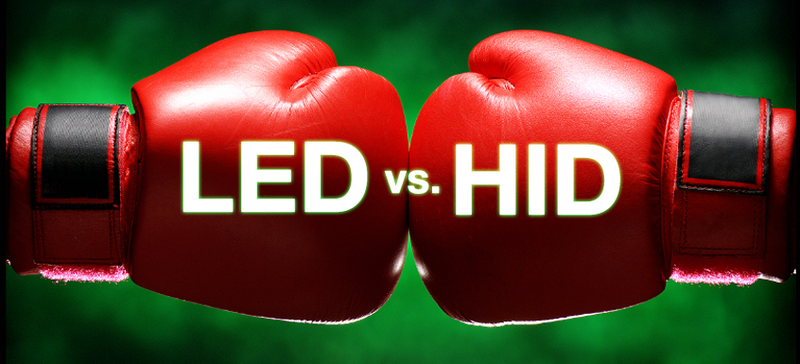HID vs LED: Lighting Solutions for your Car
The technology boom has hit automotive industry as hard as other businesses. The advancements have seeped deep down to the crucial spare parts of the automobiles. The conventional halogen bulbs that were a favourite of car manufacturer since the past are now replaced by HID and LED headlights. Though some manufacturers continue to produce new unmodified cars with the same halogen lights that were installed 20 years ago, the introduction of LED and HID will soon make halogen bulbs history. With increasing awareness regarding various lighting options available for car headlamps, a concern is raised: which one is better, HID or LED?
To better understand the new futuristic car headlights, we need to dive into their functions and features and see, which one suits best to the modern needs.
HID Lights

The Xenon HID (High Intensity Discharge) headlights, or simply HID lights as they are commonly known, are gas-discharge arc lamps that were introduced in the early 1990s. They function almost in the same way as halogen bulbs except in these, electricity passes between two electrodes inside a bulb filled with Xenon gas. The Xenon gas produces a much brighter light giving about 3000 lumens (amount of light emitted per second) and illuminating almost 90 square yards in front of the automobile. This is complemented by an expanded light dispersion afforded by the HID light design that throws light in all directions. Accordingly, HID lights enhance night driving visibility, overriding bad weather and safety concerns.
HID lights come with a wide range of colour temperatures to choose from, starting from 2000K and reaching up to 18000K, which is the highest any car light could offer. The crowning achievement of HIDs is a lifespan of 5000 hours. They are generally low on power consumption except at the initial start-up.
On the flip side, like any other car light in the market, HID lights also come with strings attached. The expensive Xenon HID headlights risk durability due to their moving parts that are the glass bulb and the filament. This makes them prone to damage due to vibrations and shocks on rough roads, so they may need replacement more often. The HID are high on power consumption at initial warm up.It takes a while for the bulbs to light up to their full capacity. This increases heat emission and lowers energy efficiency causing some reported cases of wire melting, flickering light and damage to the car’s electrical system. It is also the reason why these lights are not considered good at different beams. Over time, the lights may eventually burn out after giving varied colour temperatures than those desired originally. Fortunately, this power requirement may be provided by using a ballast to create the preliminary surge of electricity and later regulate it.
HID lights also have the glare issue. The tremendous output of light blinds other drivers on the road and may cause accidents. This issue may be resolved by installing a projector to focus the beam. Another hitch in installing HID lights, especially for those who want to improve their old car, is that they may not retrofit in an older car due to their bigger distinctive shape. Adjustments have to be made if one wants to switch from halogens to HID and this may burn a hole in the pocket.
Pros
- Produces brighter light
- Expanded light dispersion
- Wide range of colour temperatures
- Greater life span
Cons
- Expensive
- Low durability, prone to damage
- High on power consumption at initial warm up
- Increased heat emission
- High glare issue
- Difficult to fit in old cars
LED Lights

LEDs (light emitting diodes) are relatively new to the automotive industry compared to HID lights. The first LED headlight bulbs were introduced in 2004 with Audi R8. To simplify our understanding of LED we can say that LED makes use of electrical conductors that emit light when current is passed through them activating electrons that release photons (the smallest fraction of light) in the process of electroluminescence. The ultimate advantage of LED over halogen bulb and other lights is their durability and longevity. LED does not have any moving parts like a filament and a bulb, making them vibration and shock resistant. The solid LED structure boasts a lifespan of 25000 hours.
The energy efficient LED lights draw low on power than halogens or HID lights, without the need for initial warm up. Hence LED lights provide a steady flow of light with a nice focused beam. The colour temperature measures around 5000K giving off a bright white light with a tinge of blue. The output is higher than traditional halogen bulbs that offer an off-white yellowish light up to 4300K. Although LED lights offer a lower range of colour temperature than HID lights, the 5000K output is the recommended temperature by experts. This works as a blessing in disguise by eliminating glare problem that needs suitable housing and projection. Despite lower light dispersion and visibility distance than HID headlights, LED headlamps cover a far greater distance than halogen bulbs while operating on very low power. The power-saver feature is actually the mainstay of LED headlights.The advent of electric cars and the foreseeable shift towards hybrid and electric vehicles in the near future make LEDs the final choice of car manufacturers. The smaller size of LED headlights permits greater manipulation with shapes and designs.They conveniently fit into the headlight shape of various car models making it easy to upgrade old vehicles.
Another area worth mentioning is the auxiliary cooling required by the LED. Unlike halogen bulbs or HID lights, LED car lights do not heat up as they glow. The flowing electricity heats up the bottom of the LED emitter that may melt adjacent assemblies or cables therefore, the auxiliary cooling system comes hand in hand with the LED regulating the temperature and increasing its lifespan.
Pros
- High durability
- Long-lasting
- Shock resistant
- Longer lifespan
- Energy efficient
- No initial warm-up
- Steady flow of light with a nice focused beam
- Higher light output
- Does not have glare issue
- Does not heat up
- Expanded light dispersion
- Saves power
- Easy to install
- Greater manipulation with shapes and designs
Cons
- They are expensive
- Need cooling through an auxiliary cooling system
In a nutshell…
LED is the light of the future and the best option. A thorough comparison shows that its time for the aging boomers to give way to the high-tech LED headlights. The HID lights are second in lead due to their fragility, high power consumption at the initial warm up and limited configuration options. Although HID and LED both come with the same lavish price tag, LED light is the option worth every penny it costs.
Check LED Lights Categories:


